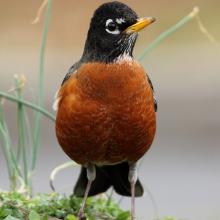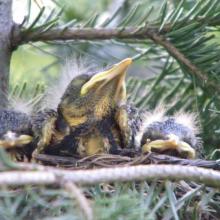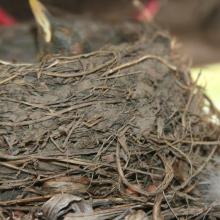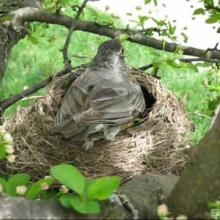

Join BirdNote tomorrow, November 30th!
Illustrator David Sibley and actor H. Jon Benjamin will face off in the bird illustration battle of the century during BirdNote's Year-end Celebration and Auction!
How does a robin know a worm is in one exact spot? Does it see the worm or hear it? Smell it? Sense its movements through its feet? To find the answer, researchers buried worms in soil in a tray. They covered the soil with a thin but opaque sheet of cardboard, followed by more soil, so the robin couldn’t see the worms. Still, the robin found them with ease. The scientists concluded the birds are listening for their prey. There’s always more to learn about birds!
BirdNote gives you the sounds of birds every day, and you can get the sights as well when you follow us on Instagram, at BirdNote Radio. / @BirdNoteRadio
BirdNote®
Does a Robin Hear Its Worm?
Written by Bob Sundstrom
This is BirdNote.
[American Robin call]
As a robin hops across a lawn or garden, it cocks its head to one side and then the other. A moment later, it jabs its yellow beak to the earth and comes up with an earthworm.
[American Robin call]
How did the robin know a worm was in that exact spot? Did it see the worm or hear it? Smell it? Or sense its movements through its feet?
[American Robin call]
Experiments with captive robins first determined the birds weren’t smelling worms or sensing their vibrations. So the birds must have been seeing or hearing them, right? To learn more, researchers buried worms in soil in a tray. They covered the soil with a thin but opaque sheet of cardboard, followed by more soil, making it impossible for a robin to see the worms. Still, the robin effectively found the worms!
[American Robin call]
The scientists concluded that robins are successfully listening for their prey, even if they can’t see, smell or feel it.
[American Robin song]
For BirdNote, I’m Mary McCann.
[American Robin song]
BirdNote gives you the sounds of birds every day, and you can get the sights as well when you follow us on Instagram, at BirdNote Radio. / @BirdNoteRadio
###
Producer: John Kessler
Executive Producer: Sallie Bodie
Editor: Ashley Ahearn
Producer: Mark Bramhill
Associate Producer: Ellen Blackstone
Bird sounds provided by The Macaulay Library of Natural Sounds at the Cornell Lab of Ornithology, Ithaca, New York. ML133356 AMRO Recordist G Keller. ML168300 AMRO Recordist W Hershberger.
BirdNote’s theme was composed and played by Nancy Rumbel and John Kessler.
© 2020 BirdNote August 2020 / July 2022 / September 2024 Narrator: Mary McCann
ID# AMRO-18-2020-08-20 AMRO-18
Source: http://web2.uwindsor.ca/courses/biology/dmennill/360/article.pdf
http://www.loe.org/shows/segments.html?programID=13-P13-00018&segmentID…









